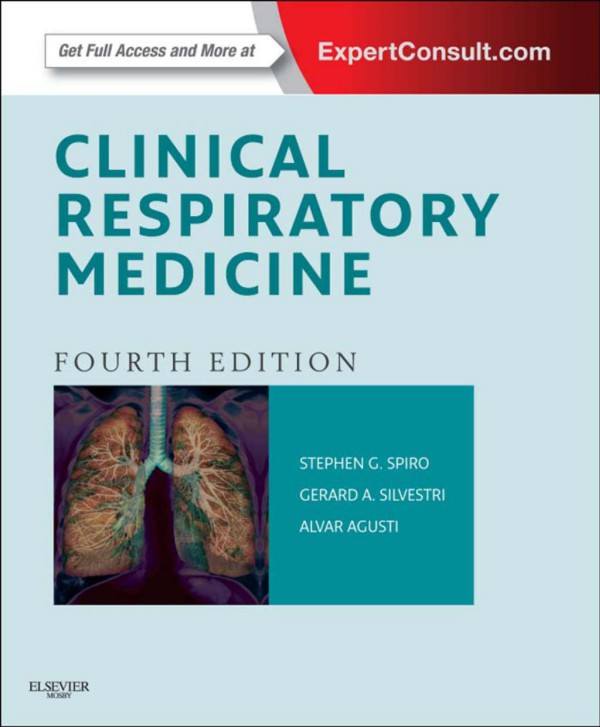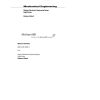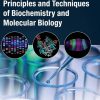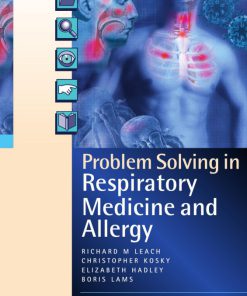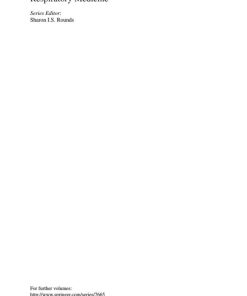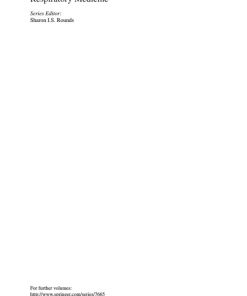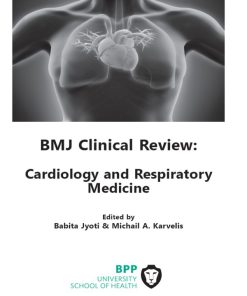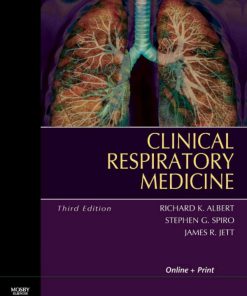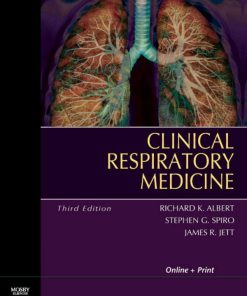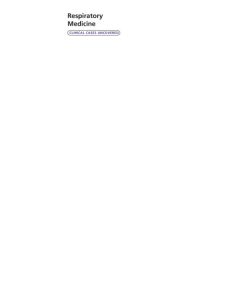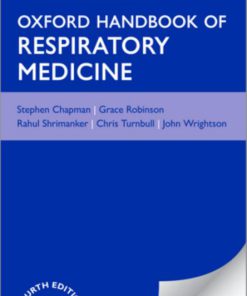Clinical Respiratory Medicine 4th Edition by Stephen Spiro, Richard Albert, Gerard Silvestri, Alvar AgustÃ, James Jett 1455707929 9781455707928
$50.00 Original price was: $50.00.$25.00Current price is: $25.00.
Authors:Agusti´ Alvar.,Silvestri Gerard A.,Spiro, Stephen G. , Author sort:Agusti´ Alvar.,Silvestri Gerard A.,Spiro, Stephen G. , Published:Published:Apr 2015
Clinical Respiratory Medicine 4th Edition by Stephen Spiro, Richard Albert, Gerard Silvestri, Alvar Agustí, James Jett – Ebook PDF Instant Download/Delivery. 1455707929, 9781455707928
Full download Clinical Respiratory Medicine 4th Edition after payment
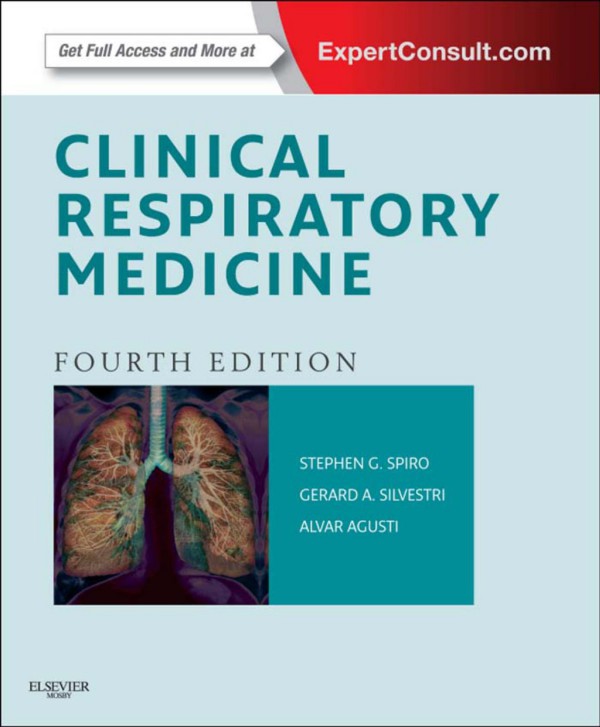
Product details:
ISBN 10: 1455707929
ISBN 13: 9781455707928
Author: Stephen G. Spiro; Richard K. Albert; Gerard A Silvestri; Alvar Agustí; James R. Jett
2013 BMA Highly Commended Award in Internal Medicine! Clinical Respiratory Medicine provides practical guidance to help you more effectively diagnose and manage the full range of pulmonary disorders, including those seen in today’s most challenging patient populations. Now with over 400 brand-new review questions and 25 videos , this medical reference book delivers all of the answers you need to ensure the best outcomes.
Clinical Respiratory Medicine 4th Table of contents:
Section 1: Normal Structure and Function
Chapter 1: Macro and Micro Structure of the Lung
Lung Development
Normal Lung Anatomy
Chapter 2: Basic Aspects of Cellular and Molecular Biology
Molecular Biology
Cell Biology
Pitfalls and Controversies
Future Directions
Chapter 3: Respiratory Mechanics
Introduction
Structure of the Thorax and Lungs
Respiratory Mechanics
Events of the Respiratory Cycle
Summary
Controversies and Pitfalls
Chapter 4: Pulmonary Circulation
Circulatory Structure
Circulatory Physiology
Blood Flow Distribution
Regulation of Pulmonary Blood Flow
Nonrespiratory Functions of the Pulmonary Circulation
Fluid Exchange in the Pulmonary Circulation
Respiratory-Circulatory Interactions
Controversies and Pitfalls
Chapter 5: Gas Exchange
The Basis of Gas Exchange: Ventilation, Diffusion, and Perfusion
Acid-Base Relationships
Controversies and Pitfalls
Chapter 6: Control of Ventilation and Respiratory Muscles
The Respiratory Centers
Afferent Inputs to the Respiratory Centers
The Efferent Limb: the Respiratory Muscles
Respiratory Muscle Responses to Changes in Load
Testing Respiratory Muscle Function
Controversies and Pitfalls
Section 2: Diagnostic Techniques
Chapter 7: Imaging Techniques
Plain Chest Radiography
Computed Tomography
High-Resolution Computed Tomography
Magnetic Resonance Imaging
Magnetic Resonance Angiography
Pulmonary Angiography
Bronchial Artery Embolization
Superior Vena Cava Stenting
Normal Radiographic Anatomy
Points in the Interpretation of a Chest Radiograph
Computed Tomography
Interpretation of High-Resolution Computed Tomography Scans of the Lungs
Chapter 8: Positron Emission Tomography Imaging
Use of Positron Emission Tomography in Respiratory Medicine
Principles of Positron Emission Tomography Imaging
Interpretation of Positron Emission Tomography Images
Positron Emission Tomography in Diagnosis
Positron Emission Tomography in Staging
Future Innovation
Chapter 9: Pulmonary Function Testing
Spirometry
Lung Volumes
Diffusing Capacity
Tests of Gas Distribution
Arterial Blood Gas Measurement
Special Testing
Chapter 10: Exercise Testing
Clinical Indications for Exercise Testing
Exercise Intensity and Energy Requirements
Responses to Exercise in Health and Disease
Clinical Exercise Protocols
Testing Procedures
Interpretation Strategies
Summary
Chapter 11: Bronchoscopy
Types of Bronchoscopy and General Instrumentation
Indications for Diagnostic Bronchoscopy
Safety Factors in Bronchoscopy
Complications of Bronchoscopy
Special Bronchoscopic Techniques
Therapeutic Bronchoscopy Techniques
Indications for Therapeutic Bronchoscopy
Bronchoscopic Treatments for Common “benign” Lung Diseases
Summary
Chapter 12: Endobronchial and Endoesophageal Ultrasound Techniques
Transbronchial Needle Aspiration
Endobronchial Ultrasound Technique
Endoesophageal Ultrasound Technique
Combining Endobronchial and Endoesophageal Ultrasound Techniques
Restaging Patients with Lung Cancer after Chemotherapy
Conclusions and Outlook
Chapter 13: Percutaneous Biopsy Procedures: Techniques and Indications
Methods of Tissue Sampling
Percutaneous Biopsy of Intrapulmonary Lesions
Ultrasound-Guided Biopsy: General Principles
Percutaneous Sampling of Extrapulmonary Intrathoracic Tissues
Percutaneous Sampling of Extrathoracic Lesions
Chapter 14: Echocardiography in Respiratory Medicine
Echocardiographic Planes and Right-Sided Heart Structures
Assessment of Right Ventricular Function by Echocardiography
Hemodynamic Assessment of the Right side of the Heart By Echocardiography
Echocardiography in Evaluation of Specific Disease States
Conclusions
Acknowledgments
Section 3: Respiratory Pharmacology
Chapter 15: Bronchodilators
Physiologic Basis for Bronchodilator Action
Pharmacologic Basis of Bronchodilator Action
β2-Agonists: Clinical Considerations
Antimuscarinic Agents: Clinical Considerations
Theophylline
Drug Delivery
Use of Bronchodilator Drugs in Clinical Practice
Controversies and Pitfalls with Bronchodilator Drugs
The Future of Bronchodilator Therapy
Chapter 16: Antiinflammatory Drugs
Corticosteroids
Phosphodiesterase 4 Inhibitors
Pipeline Products
Controversies and Pitfalls
Conclusion
Acknowledgments
Chapter 17: Drug-Induced and Iatrogenic Respiratory Diseases
Incidence and Risk Evaluation
Diagnosing Drug-Induced Respiratory Disease
Patterns of Drug-Induced Respiratory Disease
Controversies and Pitfalls
Acknowledgment
Section 4: An Approach to Respiratory Symptoms
Chapter 18: Cough
Cough in Health and Disease
The Cough Reflex
Differential Diagnosis of Cough
Clinical Assessment
Further Investigations
Treatment
Unexplained Chronic Cough
Conclusion
Chapter 19: Dyspnea
What Is Dyspnea?
Mechanisms of Dyspnea
The Language of Dyspnea
Acute Dyspnea
Chronic Dyspnea
Palliation of Dyspnea
Chapter 20: Hemoptysis
Differential Diagnosis
Patient Evaluation
Diagnostic Algorithm
Massive Hemoptysis
Summary
Chapter 21: Chest Pain
Differential Diagnosis
Patient Evaluation
Treatment
Section 5: Infectious Diseases
Chapter 22: Pulmonary Host Defenses
Structural Defenses
Specific Cell Responses
Antimicrobial Molecules
Complement
Antimicrobial Peptides
Innate Immune Receptors
Inflammatory Mediators
Summary
Chapter 23: Approach to the Diagnosis of Pulmonary Infection
The Approach
Controversies and Pitfalls
Chapter 24: Community-Acquired Pneumonia
Burden of Disease
Clinical Presentation
Risk Factors
Patient Evaluation/Diagnostics
Treatment
Specific Complications
Prevention
Controversies and Pitfalls
Acknowledgment
Chapter 25: Viral Pneumonia
Burden of Disease
Pathogens
Clinical Features
Diagnosis
Treatment
Controversies and Pitfalls
Conclusions
Chapter 26: Nonbacterial Infectious Pneumonia
Fungal Pneumonias
Parasitic Pneumonias
Chapter 27: Nosocomial Respiratory Infections
Definitions
Epidemiology
Pathogenesis
Etiologic Agents
Prevention
Diagnosis
Treatment
Chapter 28: Pneumonia in the Non–HIV-Infected Immunocompromised Patient
Overview
General Principles of the Clinical Approach
Clinical Assessment and Diagnostic Protocols
Specific Clinical Entities
Controversies and Pitfalls
Chapter 29: Pulmonary Infections in Patients with Human Immunodeficiency Virus Disease
Epidemiology, Risk Factors, and Pathophysiology
Clinical Features
Diagnosis
Treatment
Clinical Course and Prevention
Prognosis
Controversies and Pitfalls
Chapter 30: Noninfectious Conditions in Patients with Human Immunodeficiency Virus Infection
Respiratory Symptoms and Pulmonary Function
Neoplasia
Inflammatory Pulmonary Disorders
Miscellaneous Conditions
Controversies and Pitfalls
Chapter 31: Tuberculosis and Nontuberculous Mycobacterial Infections
Tuberculosis
Diseases Caused by Nontuberculous Mycobacteria
Section 6: Critical Care Respiratory Medicine
Chapter 32: Invasive Mechanical Ventilation
Indications and Contraindications
Techniques
Principles of Respiratory System Mechanics Relevant to Mechanical Ventilation
Practical Approach to Ventilating Patients with Obstructive Airway Disease
Dynamic Hyperinflation and Auto-Peep
Practical Approach to Ventilating Patients with Restrictive Pulmonary Disease
Complications of Mechanical Ventilation
Ventilator-Induced Lung Injury
Weaning from Mechanical Ventilation
Failure to Wean from Mechanical Ventilation
Controversies and Pitfalls
Chapter 33: Noninvasive Mechanical Ventilation
Indications for Implementation of Noninvasive Ventilation
Modes
Equipment
Clinical Indications
Physiologic Effects of Noninvasive Ventilation
Future Directions
Controversies and Pitfalls
Conclusions
Chapter 34: Airway Management in the Intensive Care Unit
Indications for Airway Support
Noninvasive Ventilation
Airway Assessment
Basic Airway Maneuvers and Airway Adjuncts
Endotracheal Intubation with Muscle Relaxation
surgical airways
Controversies and Pitfalls in Airway Management
Chapter 35: Hemodynamic Monitoring in Critical Illness
Circulation Model
Monitoring Devices
Arterial Waveform Analysis
Esophageal Doppler Monitoring and Ultrasound Imaging
Chapter 36: Acute Respiratory Distress Syndrome
Pathophysiology, Histopathology, and Etiology
Definition, Incidence, and Severity
Genetics
Ventilator-Induced Lung Injury
Ventilatory Management for Acute Respiratory Distress Syndrome
The Use of Positive End-Expiratory Pressure in Acute Respiratory Distress Syndrome
Rescue Strategies for Refractory Hypoxemia
Supportive Treatment
Prognosis and Long-Term Survival
Controversies and Pitfalls
Section 7: Airway Diseases
Chapter 37: Upper Airway Disease: Rhinitis and Rhinosinusitis
Upper Airway
Rhinitis
Rhinosinusitis
Diagnosis, Evaluation, and Tests
Treatment
Clinical Course and Prevention
Controversies and Pitfalls
Chapter 38: Asthma: Epidemiology, Pathophysiology, and Risk Factors
Epidemiology
Pathogenesis
Risk Factors
Trigger Factors
Chapter 39: Diagnosis and Management of Asthma in Adults
Definition and Key Features of Asthma
Pathophysiologic Basis of Asthma
Asthma Heterogeneity and Clinical Subgroups of Patients with Asthma
Genetics of Asthma
Diagnosis
Management of Stable Asthma
Management of Important Patient Subgroups
Controversies and Pitfalls
Summary
Chapter 40: Occupational Asthma
Epidemiology
Risk Factors
Pathophysiology
Clinical Features
Diagnosis
Clinical Course
Prevention
Treatment
Controversies and Pitfalls
Chapter 41: Chronic Obstructive Pulmonary Disease: Epidemiology, Pathophysiology, and Clinical Evaluation
Definitions and Diagnostic Considerations
Pathology
Etiology
Epidemiology
Natural History and Prognosis
Pathogenesis
Pathophysiology
Systemic Effects and Comorbidities
Clinical Features
Patient Assessment
Chapter 42: Treatment of the Stable Patient with Chronic Obstructive Pulmonary Disease
Multicomponent Disease
Treatable Disease
Respiratory Manifestations
Systemic Manifestations
Exacerbations, Hospitalization, and Discharge Criteria
Controversies and Pitfalls
Conclusion
Chapter 43: Management of Exacerbations in Chronic Obstructive Pulmonary Disease
Epidemiology
Pathophysiology
Clinical Features
Diagnosis
Treatment
Clinical Course and Prevention
Conclusion
Chapter 44: Cystic Fibrosis
Genetics
Pathophysiology
Clinical Features
Diagnostic Approach
Clinical Course of Lung Disease and Principles of Therapy
Treatment
Complications
Prognosis
Controversies and Pitfalls
Conclusion
Chapter 45: Bronchiectasis
Epidemiology
Pathology
Pathogenesis
Clinical Features
Diagnosis and patient assessment
exacerbations
Antibiotic Therapy
vaccination
Alternative Therapy
Physiotherapy
Management
Complications
Prognosis
Controversies and Pitfalls
Conclusion
Section 8: Parenchymal Lung Diseases
Chapter 46: Approach to Diagnosis of Diffuse Lung Disease
Initial Clinical Evaluation
Diagnostic Procedures
Integrated Diagnosis in Diffuse Lung Disease
Treatment
Controversies and Pitfalls
Chapter 47: Idiopathic Pulmonary Fibrosis and Other Interstitial Lung Diseases
Idiopathic Pulmonary Fibrosis
Nonspecific Interstitial Pneumonia
Respiratory Bronchiolitis Interstitial Lung Disease
Desquamative Interstitial Pneumonia
Acute Interstitial Pneumonia
Lymphoid Interstitial Pneumonia
Controversies and Pitfalls
Chapter 48: Sarcoidosis
Epidemiology
Etiology and Risk Factors
Genetic Factors
Pathophysiology
Clinical Features
Diagnosis
Biomarkers of Disease Activity
Treatment
Clinical Course
Controversies and Pitfalls
Chapter 49: Eosinophilic Lung Disease
The Eosinophil Leukocyte and Eosinophilic Pneumonia
Eosinophilic Lung Diseases of Known Origin
Eosinophilic Lung Disease of Unknown Origin
Chapter 50: Organizing Pneumonia
Definition
Pathogenesis
Clinical and Imaging Features
Diagnosis
Treatment of Cryptogenic Organizing Pneumonia
Severe Organizing Pneumonia
Acute Fibrinous and Organizing Pneumonia
Controversies and Pitfalls
Chapter 51: Silicosis and Coal Worker’s Pneumoconiosis
Sources of Exposure
Epidemiology
Pathophysiology
Genetics
Histopathologic Changes
Clinical Features and Diagnosis
Clinical Course, Treatment, and Prevention
Chapter 52: Asbestosis
Epidemiology, Risk Factors, and Pathophysiology
Clinical Features
Diagnosis
Treatment
Clinical Course
Asbestos-Related, Nonmalignant Pleural Disorders
Controversies and Pitfalls
Chapter 53: Connective Tissue Diseases
Epidemiology
Genetics
Pathogenesis
Lung Pathology
Clinical Features
Diagnostic TESTing
Treatment
Controversies and Pitfalls
Chapter 54: Rare Diffuse Interstitial Lung Diseases
Rare Cystic Lung Diseases
Other Rare Diffuse Lung Diseases
Pulmonary Manifestations of Rare Systemic Diseases
Chapter 55: Extrinsic Allergic Alveolitis
Risk Factors
Clinical Features
Imaging
Other Diagnostic Testing
Treatment
Prognosis
Controversies and Pitfalls: A Focus on Treatment
Chapter 56: Toxic Inhalational Lung Injury
Epidemiology
Etiology and Risk Factors
Clinical Features and Diagnosis
Controversies and Pitfalls
Section 9: Pulmonary Vascular Disorders, Vasculitides, and Hemorrhage
Chapter 57: Pulmonary Embolism
Epidemiology, Risk Factors, and Pathogenesis
Clinical Features
Diagnosis
Treatment
Controversies and Pitfalls
Chapter 58: Pulmonary Hypertension
Definition
Classification
Pathobiology
Diagnostic Approach
Approach to Therapy
Survival and Outlook
Controversies and Pitfalls
Chapter 59: Pulmonary Vasculitis and Hemorrhage
Pulmonary Vasculitis
Alveolar Hemorrhage Syndromes
Section 10: Sleep-Disordered Breathing
Chapter 60: Obstructive Sleep Apnea: Epidemiology, Risk Factors, and Pathophysiology
Epidemiology
Risk Factors for Obstructive Sleep Apnea
Pathophysiology
PathogenEsis
Controversies and Pitfalls
Chapter 61: Obstructive Sleep Apnea: Clinical Features, Diagnosis, and Treatment
Clinical Features
Physical Examination
Diagnosis
Diagnosis
Treatment
Controversies and Pitfalls
Chapter 62: Obesity Hypoventilation Syndrome
Epidemiology
Risk Factors
Pathophysiology
Clinical Features
Diagnosis
Clinical Course: Morbidity and Mortality
Treatment
Conclusions
Controversies and Pitfalls
Section 11: Chest Wall Disorders
Chapter 63: Scoliosis and Kyphoscoliosis
Epidemiology, Risk Factors, and Pathophysiology
Genetics of Idiopathic Scoliosis
Kyphosis
Effects of Chest Wall Deformity on Respiratory and Cardiac Function
Clinical Features
Progression of Curvature
Diagnosis
Treatment
Controversies and Pitfalls
Chapter 64: Diseases of the Thoracic Cage and Respiratory Muscles
Respiratory Muscle Pump
Respiratory Presentations of Neurologic and Chest Wall Disease
Thoracic Disorders
Controversies and Pitfalls
Section 12: Lung Tumors
Chapter 65: Lung Cancer: Epidemiology, Surgical Pathology, and Molecular Biology
Epidemiology
Surgical Pathology and Cytopathology
Molecular Biology
Chapter 66: Lung Cancer: Clinical Evaluation and Staging
Symptomatic Presentation
Asymptomatic Presentation
Lung Cancer Staging
Future Directions
Chapter 67: Lung Cancer: Treatment
Non–Small Cell Lung Cancer
Small Cell Lung Cancer
Prophylactic Cranial Irradiation
Paraneoplastic Syndromes and Other Common Complications
Palliative Care
Conclusion
Chapter 68: Benign Lung Tumors
Detection and Diagnosis
Classification
Benign Epithelial Neoplasms
Benign Mesenchymal Neoplasms
Benign Neoplasms: Miscellaneous
Non-Neoplastic Tumors
Section 13: Disorders of the Pleura and Mediastinum
Chapter 69: Pleural Effusion, Empyema, and Pneumothorax
Pleural Effusion
Pneumothorax
Chapter 70: Malignant Pleural Mesothelioma
Epidemiology
Pathogenesis
Pathology
Clinical Presentation
Diagnosis
Staging
Prognosis
Management
Controversies and Pitfalls
Conclusion
Chapter 71: Disorders of the Mediastinum
Overview of Mediastinal Masses
Diseases of Anterior Mediastinum
Diseases of Middle-Posterior Mediastinum
Diseases of Paravertebral Compartment
Miscellaneous Disorders of the Mediastinum
Differential Diagnosis
Section 14: Thoracic Surgery
Chapter 72: Chest Tube Insertion and Management
Indications and Contraindications
Technique
Chest Tube Management
Special Considerations
Malignant Pleural Effusions
Chapter 73: Preoperative Pulmonary Evaluation
Pulmonary Physiology
Postoperative Pulmonary Complications
Management
Conclusion
Chapter 74: Diagnostic Thoracic Surgical Procedures
Preoperative Considerations
Clinical Application of Diagnostic Thoracic Procedures
Conclusion
Chapter 75: Lung Transplantation
History
Current Trends in Lung Transplantation
Survival
General Selection Criteria
Donor Selection and Management
Donor Graft Management
Lung Allograft Implantation
Noninfectious Complications
Infectious Complications
Pitfalls of Immunosuppressive Therapy
Medical Complications in Lung Transplant Survivors
Section 15: Special Clinical Conditions
Chapter 76: Pregnancy
Pulmonary Physiology
Complications and Disorders of Pregnancy
Controversies and Pitfalls
Chapter 77: Pulmonary Complications of Hematopoietic Stem Cell Transplantation
Overview of Hematopoietic stem cell transplantation
Posttransplant Pulmonary Complications
Diagnostic Evaluation
Controversies and Pitfalls
Chapter 78: Hepatic and Biliary Disease
Risk Factors
Pathophysiology
Clinical Features
Diagnosis
Treatment
Clinical Course
Pitfalls and Controversies
Chapter 79: Inflammatory Bowel Disease
Epidemiology
Clinical and Pathologic Features
Treatment
Controversies and Pitfalls
Conclusion
Chapter 80: Air Pollution
History
Composition of Air Pollution
Outdoor Air Pollution
Indoor Air Pollution
Controversies and pitfalls
Conclusion
People also search for Clinical Respiratory Medicine 4th:
uw clinical research coordinator
uw clinical research
uw respiratory clinic
uw respiratory therapy

